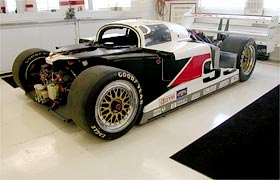|
|
|
| Prototyp : Car : Toyota Eagle MkIII - 16 FEB 02 : The Creators |
|
John Ward and Hiro Fujimori Introduction p1. Design philosophy p2. Aero (r)evolution p3. The chassis |
John Hutnick The Aero Model |
The MkIII, in detail Exterior Gallery Interior Gallery |
|
Prototyp: What is your background? How did you get involved in racing? Who was your first job with and what was your title?
John Ward: It seemed that I always wanted to be involved in racing. As early as I can remember, my dad and I listened to the Indy 500 on radio. Later on, when I was 12 years old, I saw a cutaway drawing of an ATS formula one car. That was magic! While it was not a good car, the cutaway caught my imagination. From that moment on, everything that I did was focused on building and racing cars. In High School in Tucson, AZ., I built a fiberglass monocoque sports car! I read all that I could about fiberglass and the Chaparral cars. I never got around to the bodywork but we did drive it around a bit. I went on to get my degree from the University of Arizona. After that I designed, built, and raced my own Super Vee in the early 70's until the cost got out of hand. My first real racing job was at All American Racers as a Design Engineer working under Gary Wheeler. Hiro Fujimori: I was born in Japan in 1952. I earned BE from Meijo University in Nagoya Japan. Before the MK III GTP work, I had engaged in the aerodynamic design and development of the Toyota Celica IMSA GTUs, GTOs, MK I GTP, MK II GTP, and '83, '84, '85 and '86 Eagle Indy cars. Currently I am working on motorcycle wind tunnel testing at AAR. In my childhood, I had strong interest in vehicle's mechanism and competitions. These two strong interests lead me to design, build, and race with cars. As a racecar design engineer, my first job was with Dome Co., Ltd. in Japan. |
 |
|
P: Who were the key players involved in the Toyota Eagle MkIII? What was your specific role?
JW: The Toyota MKIII project was my 3rd tour of duty at AAR. I was the Chief Designer, Hiro Fujimori was the Aerodynamics Designer, and Jim Hamilton was the Race Engineer and Vehicle Dynamics Guru. Dan himself was of course involved as well as Drino Miller (at TRD then). HF: Prior to the use of the first 20% scale wind tunnel models, I was designing internal and external aerodynamics devices, designing and building wind tunnel models, and wind tunnel testing. After the first 20% scale model wind tunnel test was completed, AAR established a model shop to build wind tunnel models under my management. |
 |
|
P: What is your design philosophy? How do you start when given a clean sheet of paper?
JW: When I started on this project, AAR had a MKII car that they were running, and they got it to win some races, but it was a very difficult car to tune. As with anything else, we benefited from what went before. It was clear that the MKII lacked front downforce, which was a common problem with all of those cars. Most cars at the time used the "European Style" underbody, i.e. one long underbody starting at the front of the nose and continuing back to the diffusers and on back. This was the way that the MKII was also. I came in with the advantage of a fresh look and a strong formula car background. What we ended up with was a separate nose diffuser, followed by a more or less formula car type underbody. The front tires helped pull air under the nose, and like magic, the nose was firmly pulled down. Hiro did a great job in the tunnel (1/10th scale moving road!)and Jim did a great job tuning the chassis. The car was very good from the beginning. Rocky Moran drove it first at a little track in N. Las Vegas. He knew right away that this was going to be a good car. HF: My design philosophy are that the design with simple, effective, timely, contemporary and with minimum compromise. When I have a clean sheet of paper, first I will list all ideas from existing data, experienced information and educated guesses. Then I will make a layout drawing to package all of my ideas, within the regulations required, with my interpretation of the regulations. Based on this layout, I will then design the specific wind tunnel model and build all the parts necessary for the wind tunnel tests. The wind tunnel test results will give the answer to final design of the car. This sequence is repeated until we obtain acceptable result. |
 |
| MkIII: Aero (r)evolution... > > |